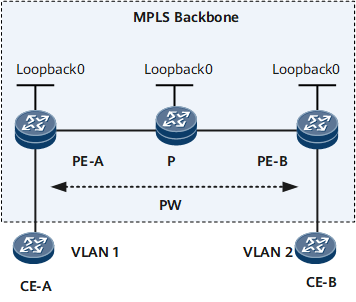LSP Trace Test
An NQA label switched path (LSP) trace test monitors the forwarding paths of Label Distribution Protocol (LDP) LSPs and TE LSPs and collects statistics about each router along each forwarding path. Figure 1 illustrates a network on which an LSP trace test is performed. The LSP trace test process is as follows:
The NQA client (PE-A) constructs a UDP MPLS Echo Request message with the destination IP field set to an IP address on the network segment 127.0.0.0/8. After that, the NQA client searches for an LSP. For a TE LSP, the message can be sent by a tunnel interface and forwarded along a specified CR-LSP. The Echo Request message includes the downstream mapping TLV carrying downstream information, including the next-hop address and outgoing label value. The TTL of the first Traceroute Echo Request message sent is 1.
The MPLS Echo Request message is forwarded through the specified LSP in the MPLS domain. After the message reaches the first hop of the LSP, its TTL expires. The first hop then replies with an MPLS Echo Reply message.
The NQA client continues to send the same Echo Request message, with the TTL increasing by 1 each time. This process continues until all the routers along the LSP reply with their MPLS Echo Reply messages. Then, the LSP trace process ends.
Using the MPLS Echo Reply messages received from each hop, the NQA client obtains the LSP forwarding path between the NQA client and the destination and collects statistics about each router along the forwarding path. The data obtained is used to evaluate the LSP status.
